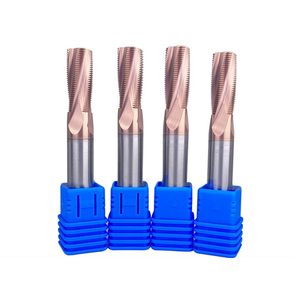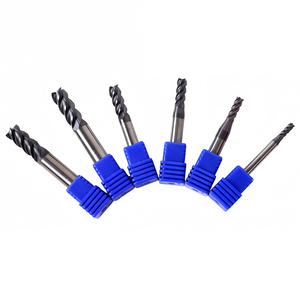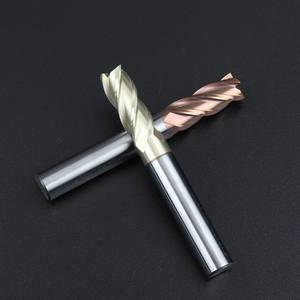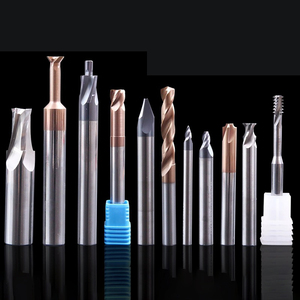
All categories
Featured selections
Trade Assurance
Buyer Central
Help Center
Get the app
Become a supplier

(1919 products available)







































Carbide end mills are intended for various applications. There are at least five types of these tools, mainly differentiated by shape and function. Here is a breakdown of the most common end mills, including their intended applications.
This is the most common type of end mill. It features a flat cutting edge and produces a square bottomed trench. The design allows it to carry out precise and controlled grinding. It is suitable for grinding aluminum and other soft materials.
It is also ideal for developing sharp corners and edges. These qualities make it a popular choice in milling operations requiring deep and precise machining, such as vertical machining centers VMCs.
This type of end mill features a rounded ball-shaped cutting edge. It is designed for milling ball grooves. Ball end mills are suitable for carrying out grinding operations on three-dimensional shapes.
They are also good for creating fillets and curved surfaces. This makes them appropriate for not just finishing but also semi-finishing cuts in complex designs. Generally, ball-end mills are perfect for softer materials like plastics and metals.
This end mill has a bevelled edge that can cut a 45-degree chamfer. It is specifically designed for cutting chamfers or the angled edge along a flat surface. Mainly, they are employed to deburr or chamfer parts after milling operations.
But they can also be used for sinks, slots, and pocketing in softer materials. Their easy deburring capability makes them a valuable tool for improving the finishing phase in a milling operation.
These end mills are similar to square end mills. The only difference is that they feature a radius on the square cutting edge. This corner radius reduces chipping and increases tool life.
They are ideal for machining corners with less wear on the tool or workpiece. It can handle mild grinding of the corner edges of a given workpiece. Though they can't grind as effectively as ball end mills, they can still grind fillets and rounded corners.
These end mills have an angled fluted profile and are specially designed for engraving or 3D machining. They are used to mill tapered surfaces. Their design allows them to carry out fine detailing work, such as engraving patterns on the surface of a workpiece.
They can also handle tapered cuts on inclined surface workpieces. This makes them valuable in mould-making industries, which require intricate designs and undercuts. The end mills are also effective in milling soft materials like plastic and wood.
End mills come in different varieties. Mainly the distinctions are based on material composition and durability. But some durable end mills are constructed with cobalt steel, HSS, and carbide. Each type of end mill material has its advantages and differs in durability and intended applications. Here is a breakdown of some of the common materials end mills are made of.
These end mills are formulated from a special blend of HSS with 5% to 8% cobalt added. The cobalt Steel allows the end mill to maintain its hardness even at elevated temperatures. Thus, they can carry out heavy-duty machining without losing their cutting edge.
Cobalt steel end mills are more durable than standard HSS end mills. This is because they can operate at higher speeds and resist wear and deformation. As a result, they are suitable for milling harder materials like stainless steel and titanium alloys.
HSS end mills are formulated from a special blend of steel that can withstand high operational speeds without breaking or bending. The unique properties allow them to maintain their sharpness longer than conventional steel tools, even under intensive use.
Though they can withstand heat, they are less resistant to wear than other materials. So, they are mostly limited to softer materials like aluminum or plastics. But because of their affordability and durability, they are an ideal milling tool for general machining applications.
These end mills are manufactured from tungsten carbide, a very hard and wear-resistant material. They hold their cutting edge for much longer than HSS or Cobalt steel, making them suitable for high-precision, long-duration milling operations.
However, because of their brittleness, they can shatter under excessive impact. They can also snap if subjected to heavy side loads. They have a low thermal expansion coefficient, allowing them to maintain their characteristics even under high heat. Their anti-wear properties make them suitable for milling hard materials like steel, titanium alloys, and superalloys.
Blade length
The blade length of end mills varies by application. But generally, most of them range anywhere from 1" to 3". However, there are also some with blade lengths of up to 12". Blade length determines the thickness of the end mill. The longer the blade length, the thicker the end mill is.
Overall length
Apart from blade length, overall length is another important specification of an end mill. This is because the overall size of the end mill affects how deep the cut can go into the given workpiece. The overall length of most end mills ranges from 2" to 8".
Number of flutes
End mills have flutes that are responsible for cutting into the given workpiece. The number of flutes on an end mill influences the speed and efficiency of the milling operation. As the name suggests, single-end end mills have flutes cut into one end of the tool. On the other hand, double-end end mills have flutes on both ends.
End mill options with more flutes tend to produce smoother finishes. However, they are less efficient at removing material compared to the ones with fewer flutes. Also, they tend to be more expensive. The number of flutes also affects the style of end mill manufactured. For instance, one end mill feature flutes of varying shapes, like angled or cam. Single end mills are cheaper but less sturdy than double end ones. Double end mills are sturdier than their single counterparts because they can withstand more milling loads. However, they are pricier.
Coating
Many end mills feature special coatings that enhance cutting performance. These coatings reduce friction, increase wear resistance, and prevent built-up edges. The most common coatings are titanium nitride (TiN), titanium carbide (TiC), and zirconium nitride (ZrN).
TiN gives the end mill a characteristic gold hue. It is a soft coating that reduces friction. Though it wears out fairly quickly, it can make the end mill much more efficient, reducing thermal buildup by as high as 50%.
TiC was developed specifically for machining non-ferrous materials. It is a medium-hard coating that reduces friction and prevents built-up edges. Though less common, ZrN is a standard coating for end mills that cut advanced materials. It is a very hard coating with low friction qualities.
The primary use of end mills is for milling operations in the industrial manufacturing space. Here are some common applications for carbide end mills.
Aerospace components require very precise machining. End mills make it possible to achieve this level of precision. They also minimise material wastage, which is pivotal when machining expensive materials like titanium and high-strength steel. Moreover, end mills are designed to endure the heat and stress generated during milling. So, they are ideal for machining aerospace materials that can withstand high rotational speeds.
The intricate and precise details required in moulds for casting, plastic injection, and other processes can be easily achieved with end mills. In fact, taper and ball end mills are standard tools for hollowing out moulds and dies. Furthermore, since these end mills are formulated from durable materials, they maintain their integrity even when machining abrasive materials like aluminium.
Medical device manufacturing requires both precision and the ability to handle exotic materials like titanium and Inconel. End mills, especially those with coatings, can easily withstand the demands of this industry. They are also effective at machining difficult-to-cut materials with tight tolerances and complex geometries. So, whether it is milling the components for surgical instruments or implants, end mills are critical in this space. Moreover, end mills have high demand in the commercial space. This is more so for end mills manufactured for machining high-strength materials, titanium, and inconel. These materials are used in aerospace, defence, and medical applications. So, end mills suitable for these applications have value adding to their commercial appeal.
End mills are one of the most common cutting tools used in machining soft and hard materials. There is high demand for them since any machining space uses them to create precision components for various applications. Their ability to withstand wear and tear and be coated with different materials makes them ideal for multiple industries. Moreover, they are a staple in general machining, adding value to any shop that services clients in various industries. Overall durability and versatility make them a critical component in manufacturing. Buyers should also note that the overall cost end mills can save on repairs and replacements increases their demand significantly, making them a valuable tool for any machining business. This increases their demand and commercial value.
Buyers should consider various factors to select the right end mill for specific cutting applications. This will help ensure the end mill chosen operates efficiently and has a longer tool life. Here are these factors.
The material of the end mill is one of the first things buyers should consider. For example, they should select titanium-coated end mills for cutting high-strength materials. This is because the titanium coating will reduce friction, allowing the end mill to easily grind the material. Also, buy an HSS end mill if the buyer's machining project will be centred around softer materials like aluminium. The HSS end mill is an ideal option for general machining. So, it can also be used for VMCs of softer materials. Only choose carbide end mills for projects requiring heavy-duty cuts and precise finishes. They are the most durable end mill type and can cut almost any material, including aluminium and steel.
Buyers must first understand the terminology for various milling machine parts and their functions before considering the end mill's characteristics. The features that need consideration include the number of flutes, cutting diameter, coating, etc. Buyers should ensure the end mill they purchase has the right characteristics for their machining projects. So, for instance, choose end mills with more flutes for fine milling. Conversely, go for those with a larger cutting diameter for heavy stock removal. Moreover, buyers should also look for end mills with a standard coating. Coated end mills last longer than non-coated and are ideal for cutting harder materials. A buyer looking for a cost-effective end mill that isn't welded to a specific machine should buy a universal end mill holder.
Buyers should consider the machining requirements for specific end mills and the feasibility of carrying out those projects. To prevent buying end mills that shatter or wear out quickly, ensure the cutting tools match the buyer's machining needs. Also, in the end, consider the operational costs and projects the end mills available for. Knowing the buyer's budget will make it easier for them to purchase end mills that will meet their needs. After all, there are affordable ones for general machining to costly ones designed for heavy industrial use.
A. The first way to prolong the life of an end mill is to select the right tool for the task at hand. This reduces wear and tear and ensures the end mill can handle the machining project without shattering. Implementing cooling techniques like using a mist or flood coolant can reduce thermal buildup.
Additionally, buyers should ensure the machining parameters are always within the recommended range. Cutting too deep or using excessive feed rates will increase fatigue and wear on the cutting edges. Lastly, minimising shock and vibration can help maintain a smoother cutting action, reducing stress on the tool and extending its lifespan far beyond the rated hours of use.
A. The effectiveness of an end mill is primarily determined by its application rather than its length. Although shorter end mills offer more rigidity and control, longer end mills are ideal for deeper cuts. One cannot say shorter end mills are more effective than longer end mills. Each is suited for a specific task. Longer end mills are prone to more deflection, affecting the overall cutting accuracy. On the other hand, shorter end mills cannot reach deeper sections of a workpiece. Thus, a buyer should choose an end mill based on the machining project requirements. Longer end and short end mills can effectively complete various machining projects as long they are suitable for the task.